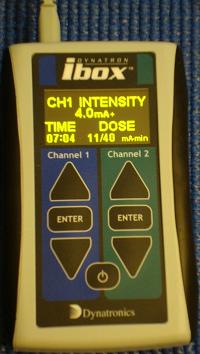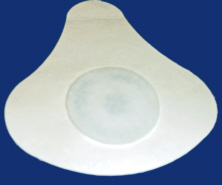|
© 2010-2012 Jerry Emanuelson
Practical iontophoresis for needle phobic patients An FDA-approved medical device originally made by Life-Tech called the NeedleBuster® was designed for this purpose for needle phobics and was available in the past to health care professionals. (Although a company in Quebec has a web page showing this product, it is no longer produced by Life-Tech, and does not actually seem to be available anywhere.) A similar competing iontophoresis product was Numby Stuff® from Iomed Clinical Systems. The complete Numby Stuff unit is not currently being sold although it looks like some replacement components and supplies can still be purchased. A more recent iontophoresis unit was LidoSite® made by Vyteris and approved by the United States Food and Drug Administration in 2004. The prescribing information for the LidoSite unit specified that it was to be used only in a professional health care setting. The LidoSite unit was made for administering about half of the dose of previous lidocaine-iontophoresis units. The LidoSite unit has not been actively marketed in a long time. In a legal document that was filed in April 2011, the company stated, "Our LidoSite product is currently dormant, and there are no plans to engage in further development, marketing or licensing of this product." Iontophoresis units cost a few hundred dollars. At one time, they could be purchased by individuals if the individual had a doctor's prescription for the device, but there have been a number of inexcusable complications to individual purchases in recent years caused by those who have no understanding of needle phobia. A major problem with the Lidocaine-iontophoresis units was that most manufacturers of these units would only market and sell them to doctors offices and hospitals, the very people who think that such units are not needed. Quite predictably, the result was that all of these products failed in the marketplace, and entered the vast graveyard of very effective, but abandoned, products that could have been very useful for needle phobics. Thousands of lives could be saved every year if the makers of iontophoresis units had a rational system for making their products available to the consumers who really need them. The current situation with the Lidocaine-specific iontophoresis units being unavailable puts many patients in a difficult position. Some patients who would otherwise use a Lidocaine-specific iontophoresis unit may be able to use the Synera/Rapydan patch. Hopefully, some company will fill the current void, and produce a Lidocaine-specific iontophoresis unit with a rational marketing plan. I don't know of any such devices made specifically for needle procedures that are available at the present time. General-purpose iontophoresis units (sold without Lidocaine) have recently been manufactured in many countries for many different uses, including the deep hydration of skin in order to prevent excessive sweating. These general-purpose iontophoresis units and electrodes are now being sold internationally without a prescription. Although even the general-purpose units that are made in the United States are shipped from the manufacturer with the intention (as stated in the product labeling) of being used only in a professional medical setting, some of these general-purpose units are quite often sold by medical supply companies without the necessity of a doctor's authorization. The Lidocaine HCl solution, though, DOES require the prescription of a licensed physician in the United States. The wider availability of general-purpose iontophoresis units in many countries may make things easier for needle phobics because, if the patient approaches a doctor with iontophoresis unit and electrodes in hand, the doctor may be much more cooperative in supplying a prescription for the Lidocaine HCl solution. In fact, a doctor will probably have a suitable Lidocaine HCl solution right there in his office. The solution does have to be lidocaine HCl (lidocaine hydrochloride). Plain Lidocaine will NOT work for iontophoresis. The solution needs to be very pure since it is going to be electrically driven underneath your skin. Do NOT try to use any of the over-the-counter numbing gels with iontophoresis units. The clinical iontophoresis units for needle procedures had a Lidocaine HCl solution with a very small amount of epinephrine. The epinephrine keeps the lidocaine HCl in the local area of the body for a much longer period of time. The epinephrine can also reduce the local skin redness and irritation that is experienced by about ten percent of the individuals using iontophoresis. Since the Lidocaine HCl/epinephrine solution is more difficult to obtain than the Lidocaine HCl without the epinephrine, many needle phobics have been forgoing the epinephrine. The numbing effect is typically 15 to 20 minutes without epinephrine and 60 to 90 minutes with epinephrine. This varies with different iontophoresis settings and among different individuals. The epinephrine causes vasoconstriction, which can make the veins more difficult to access. Always buy the Lidocaine HCl solution from a legitimate pharmacy. I have seen Lidocaine advertised for sale without a prescription by non-pharmacies on the internet. Many of these companies are not even clear whether their product is Lidocaine or Lidocaine HCl. I cannot emphasize enough the importance of getting the Lidocaine HCl from a legitimate pharmacy or directly from a doctor. You need to know exactly what you are getting. Although Lidocaine HCl has an excellent safety record, nothing is perfectly safe, and you certainly don't want anything of questionable purity. A solution called Iontocaine, which was specifically designed for use prior to needle procedures, was voluntarily removed from the market by the only authorized manufacturer. This is probably because adverse effects from Lidocaine products can occur just often enough that most manufacturers don't want to bother with what they see as a very small market for Lidocaine-iontophoresis units for needle phobics. The remainder of this page is a web page that I wrote on the general use of iontophoresis for needle phobia. It is presented here only for purposes of general information. I decided to go ahead and put it on line because many people have been wanting this information. Most people without a basic scientific understanding of iontophoresis have difficulty in using a general-purpose iontophoresis unit for a specialized purpose. I probably won't be refining this page or adding to it any further unless new iontophoresis products come onto the market that are worthy of note. Many needle phobics have been frightened away from iontophoresis because it is a big word, and the whole subject sounds mystifying. Actually, once a person gets past the strange word, and gets into the instructions for using iontophoresis, it is a very simple procedure. It is a procedure that has changed the lives of many people who suffer from needle phobia. Nevertheless, I've been disappointed at how few people have even tried using iontophoresis. Of the few who have tried, the failure rate for people using these general-purpose units seems to have been much higher that I would have expected. Iontophoresis worked very easily for me, but I spent much of my childhood studying electrochemistry, so the basic principles of iontophoresis came as second nature to me. For those who do not have this background, this rather simple process can be somewhat mystifying. The result can be that a simple error or malfunction of the cables or equipment can result in an enormous amount of frustration. If you are a needle phobic with a basic scientific or technical background, though, simple Lidocaine HCl iontophoresis can be a life-changing procedure. In the past, iontophoresis units with the lidocaine-based anesthetic solution were available. These were much easier to use for a specific purpose than the general purpose iontophoresis units. Because of less than competent marketing, however, those special lidocaine iontophoresis units that were designed especially for use with needle procedures are no longer available. Basically, iontophoresis is simply the use of a small DC electric current from a portable battery-operated device to drive a controlled amount of a local anesthetic deeply into the skin. In a Lidocaine HCl solution, the Lidocaine is a positively-charged ion. Since like charges repel, the positively-charged electrode pushes the Lidocaine deeply into the skin. In recent years, iontophoresis has become much more widely used for a larger variety of conditions, using a variety of different medicines. In many countries, the iontophoresis units and electrodes do not require a physician's authorization for purchase. In the United States, although (the last time that I checked) these units still technically needed a doctor's authorization, many sellers of these units are no longer requiring a specific written physician's authorization. Please don't ask me about whether a particular unit from a particular seller requires a doctor's written authorization. This is a complicated issue, and I am neither a lawyer nor a doctor. This web page is read around the world, and the regulations are different in every country. Many people simply buy what they can without the doctor's written authorization, then obtain the Lidocaine Hydrochloride solution from directly from the physician after telling the doctor that they want to use it for the iontophoresis unit. As explained below, there are several advantages to doing the iontophoresis procedure in the doctor's office or clinic immediately before the scheduled needle procedure. If you do the procedure at home, the numbing effects may have worn off before you get the needle procedure done. As I explained on the main Needle Phobia page, it is very important to obtain the Lidocaine HCl solution from a doctor or from a licensed pharmacy with a doctor's prescription. All physicians are very familiar with Lidocaine HCl. Most doctors are not very familiar with iontophoresis, and they are (understandably) usually very reluctant to write a prescription for devices that they know little about. Most needle phobics will have much better success if they can bring an iontophoresis unit with a suitable electrode to the doctor's office or clinic. Needle phobia is one of many conditions where a successful outcome requires that the patients take the lead. If you decide to use the unit for the first time in a doctor's office or clinic, be sure to familiarize yourself with the unit as much as possible while you have it at home. Make sure to install the batteries before taking it to a doctor's office or clinic.
Although I already get a very large volume of email (and I spend a lot of unpaid time answering that email), I am very interested in hearing from other people about how well these general-purpose iontophoresis units work for them. Everyone is somewhat different in this regard. I am interested in reading about your personal experiences in order to provide a better quality of information to other needle phobics.
One obvious question that many people will have is: Why can't this iontophoresis process be used for ALL medicines that currently require a needle? In some cases, other medicines could use iontophoresis. Sometimes, the medicines are just not produced and distributed in a form that is compatible with iontophoresis. In the cases of most medicines, though, iontophoresis could not be used because of the quantity of the medicine that must be administered -- or the fact that the medicine does not form electrically-charged ions when it is dissolved in water. For now, we have to accept the fact that iontophoresis does work for Lidocaine HCl, and to let the medical industry (including the local medical professionals) know that the use of iontophoresis needs to be greatly expanded. Many people who relied on iontophoresis units in the past may be able to use the Synera/Rapydan patch instead for many procedures. See the main Needle Phobia Page for more information on the Synera/Rapydan patch. This page is for informational purposes only. It is not intended to provide any medical advice. The Needle Phobia Page and this Iontophoresis page are both maintained by Jerry Emanuelson. Go to the The Needle Phobia Page.
|


